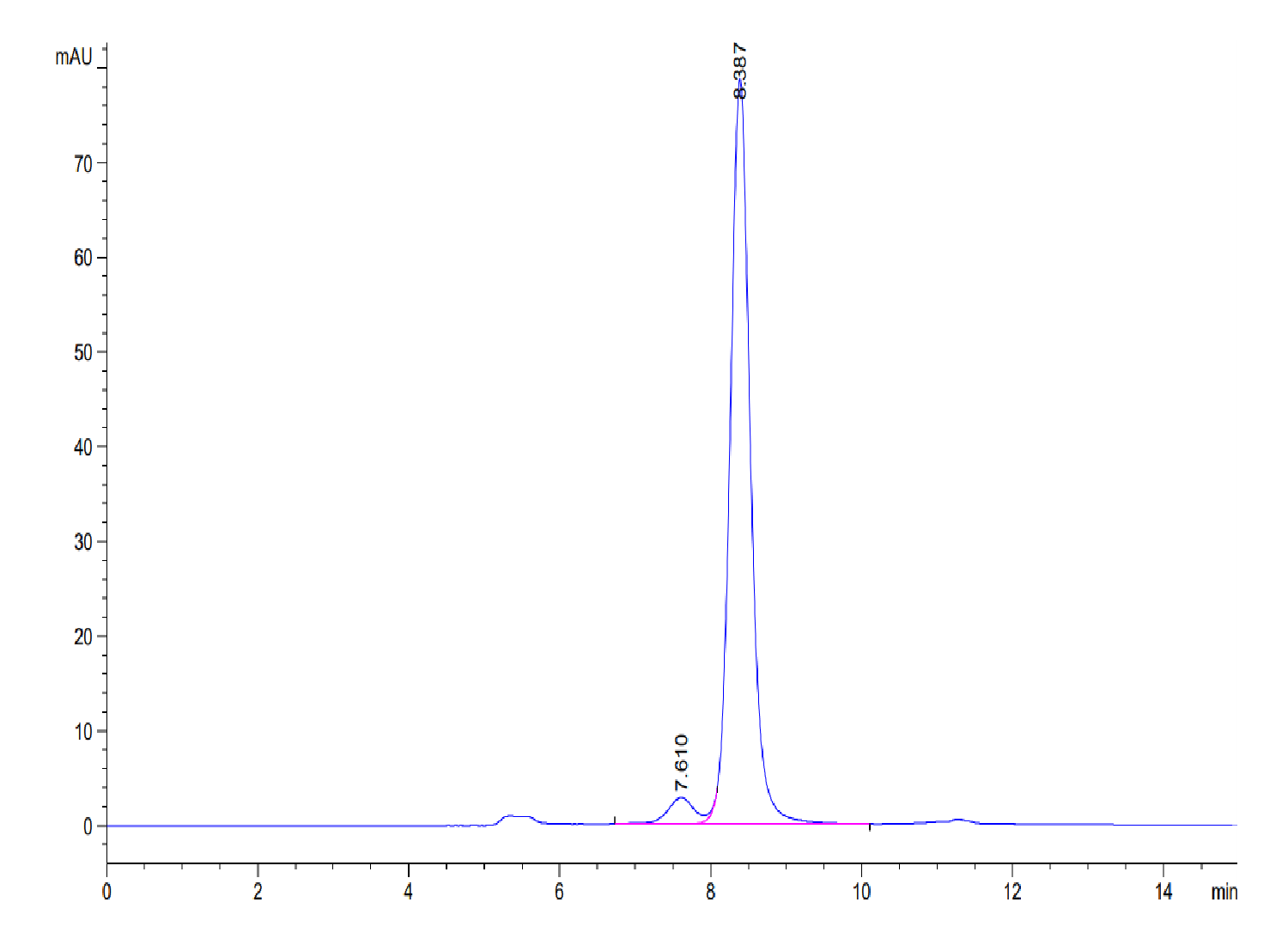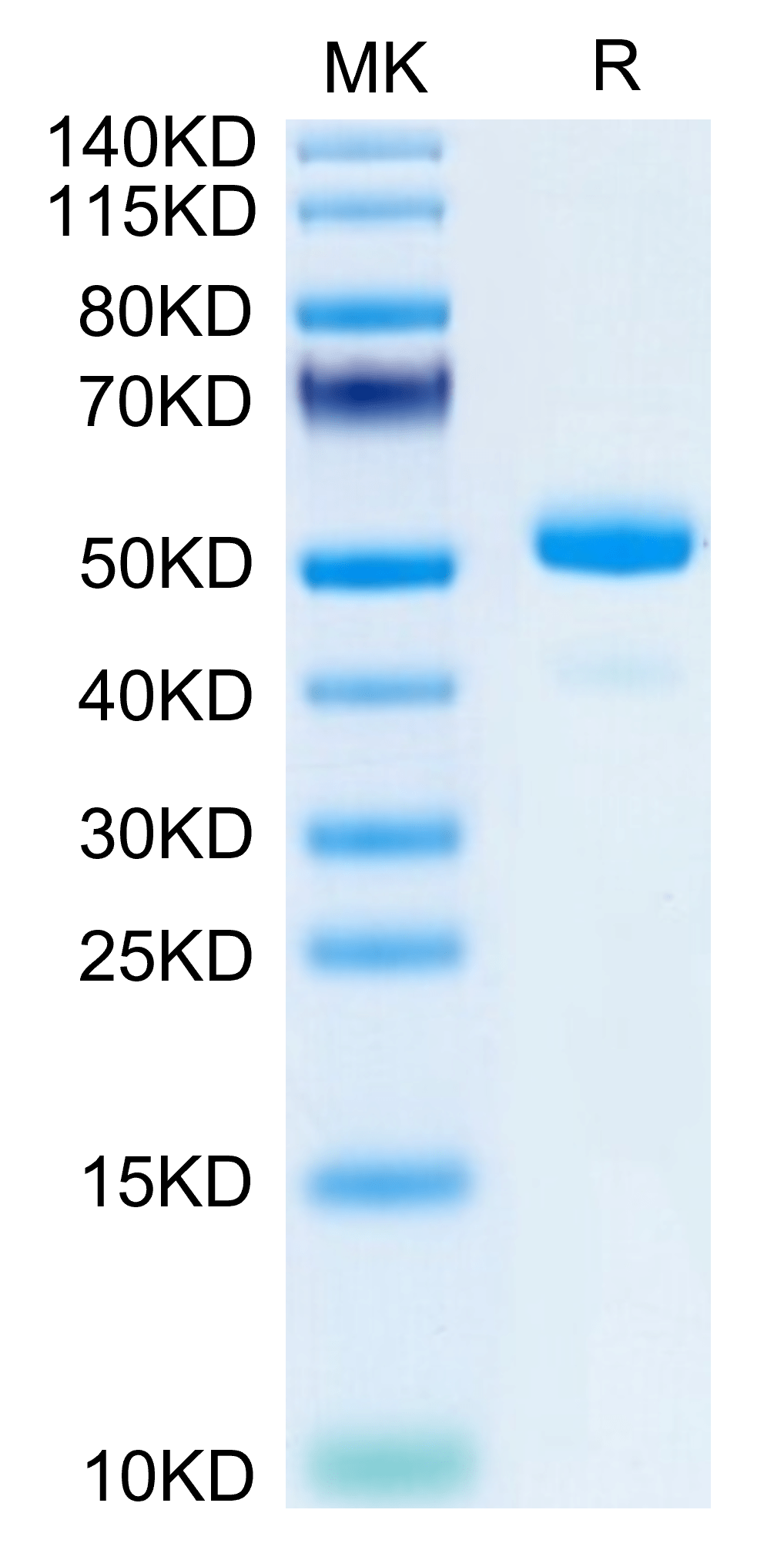| Weight | 1 lbs |
|---|---|
| Dimensions | 9 × 5 × 2 in |
| accession | P11672 |
| express system | HEK293 |
| product tag | C-hFc |
| purity | > 95% as determined by Tris-Bis PAGE;> 95% as determined by HPLC |
| background | Acute kidney injury (AKI) is one of the most common complications of various serious conditions, and early diagnosis is therefore critical for the treatment of AKI. Recent evidence demonstrates that neutrophil gelatinase- associated lipocalin (NGAL) is closely associated with AKI. Several experimental and clinical studies have shown that the expression of urine and serum NGAL increases significantly in AKI. NGAL shows potential to be a new effective early biochemical marker of AKI. Further studies are needed to confirm the significant advantages of NGAL in the diagnosis of early AKI and its value in clinical applications. |
| molecular weight | The protein has a predicted MW of 47.5 kDa. Due to glycosylation, the protein migrates to 50-60 kDa based on Tris-Bis PAGE result. |
| available size | 100 µg, 500 µg |
| endotoxin | Less than 1EU per μg by the LAL method. |
Mouse NGAL/Lipocalin-2 Protein 3780
$345.00 – $1,150.00
Summary
- Expression: HEK293
- Pure: Yes (HPLC)
- Amino Acid Range: Gln21-Asn200
Mouse NGAL/Lipocalin-2 Protein 3780
| protein |
|---|
| Size and concentration 100, 500µg and lyophilized |
| Form Lyophilized |
| Storage Instructions Valid for 12 months from date of receipt when stored at -80°C. Recommend to aliquot the protein into smaller quantities for optimal storage. Please minimize freeze-thaw cycles. |
| Storage buffer Shipped at ambient temperature. |
| Purity > 95% as determined by Tris-Bis PAGE |
| target relevance |
|---|
| Acute kidney injury (AKI) is one of the most common complications of various serious conditions, and early diagnosis is therefore critical for the treatment of AKI. Recent evidence demonstrates that neutrophil gelatinase- associated lipocalin (NGAL) is closely associated with AKI. Several experimental and clinical studies have shown that the expression of urine and serum NGAL increases significantly in AKI. NGAL shows potential to be a new effective early biochemical marker of AKI. Further studies are needed to confirm the significant advantages of NGAL in the diagnosis of early AKI and its value in clinical applications. |
| Protein names Neutrophil gelatinase-associated lipocalin (NGAL) (Lipocalin-2) (Oncogene 24p3) (24p3) (SV-40-induced 24p3 protein) (Siderocalin LCN2) (p25) |
| Gene names Lcn2,Lcn2 |
| Protein family Calycin superfamily, Lipocalin family |
| Mass 10090Da |
| Function Iron-trafficking protein involved in multiple processes such as apoptosis, innate immunity and renal development (PubMed:12453413). Binds iron through association with 2,3-dihydroxybenzoic acid (2,3-DHBA), a siderophore that shares structural similarities with bacterial enterobactin, and delivers or removes iron from the cell, depending on the context. Iron-bound form (holo-24p3) is internalized following binding to the SLC22A17 (24p3R) receptor, leading to release of iron and subsequent increase of intracellular iron concentration. In contrast, association of the iron-free form (apo-24p3) with the SLC22A17 (24p3R) receptor is followed by association with an intracellular siderophore, iron chelation and iron transfer to the extracellular medium, thereby reducing intracellular iron concentration. Involved in apoptosis due to interleukin-3 (IL3) deprivation: iron-loaded form increases intracellular iron concentration without promoting apoptosis, while iron-free form decreases intracellular iron levels, inducing expression of the proapoptotic protein BCL2L11/BIM, resulting in apoptosis. Involved in innate immunity; limits bacterial proliferation by sequestering iron bound to microbial siderophores, such as enterobactin (PubMed:15531878, PubMed:16446425). Can also bind siderophores from M.tuberculosis (By similarity). |
| Catalytic activity BINDING 72..74; /ligand="a carboxymycobactin"; /ligand_id="ChEBI:CHEBI:178051"; /evidence="ECO:0000250|UniProtKB:P80188"; BINDING 128; /ligand="enterobactin"; /ligand_id="ChEBI:CHEBI:77805"; /evidence="ECO:0000250|UniProtKB:P80188"; BINDING 147; /ligand="a carboxymycobactin"; /ligand_id="ChEBI:CHEBI:178051"; /evidence="ECO:0000250|UniProtKB:P80188"; BINDING 156; /ligand="a carboxymycobactin"; /ligand_id="ChEBI:CHEBI:178051"; /evidence="ECO:0000250|UniProtKB:P80188"; BINDING 156; /ligand="enterobactin"; /ligand_id="ChEBI:CHEBI:77805"; /evidence="ECO:0000250|UniProtKB:P80188"; BINDING 160; /ligand="a carboxymycobactin"; /ligand_id="ChEBI:CHEBI:178051"; /evidence="ECO:0000250|UniProtKB:P80188" |
| Subellular location Secreted. Cytoplasmic granule lumen. Cytoplasmic vesicle lumen. Note=Upon binding to the SLC22A17 (24p3R) receptor, it is internalized (PubMed:16377569). Releases the bound iron in the acidic lumen of cytoplasmic vesicles (By similarity). |
| Tissues Expressed in the cortical tubules of the kidney (at protein level) (PubMed:30418175). Also expressed in the medullary tubules of the kidney (PubMed:30418175). Detected in lung, spleen, uterus, vagina and epididymis (PubMed:8687399). |
| Structure Monomer. Homodimer; disulfide-linked. Heterodimer; disulfide-linked with MMP9. |
| Post-translational modification N-glycosylated. |
| Target Relevance information above includes information from UniProt accession: P11672 |
| The UniProt Consortium |
Data
 |
| The purity of Mouse NGAL/Lipocalin-2 is greater than 95% as determined by SEC-HPLC. |
 |
| Mouse NGAL/Lipocalin-2 on Tris-Bis PAGE under reduced condition. The purity is greater than 95%. |
Publications
Publications
| pmid | title | authors | citation |
|---|---|---|---|
| We haven't added any publications to our database yet. | |||
Protocols
| relevant to this product |
|---|
Documents
| # | ||
|---|---|---|
| Please enter your product and batch number here to retrieve product datasheet, SDS, and QC information. | ||














